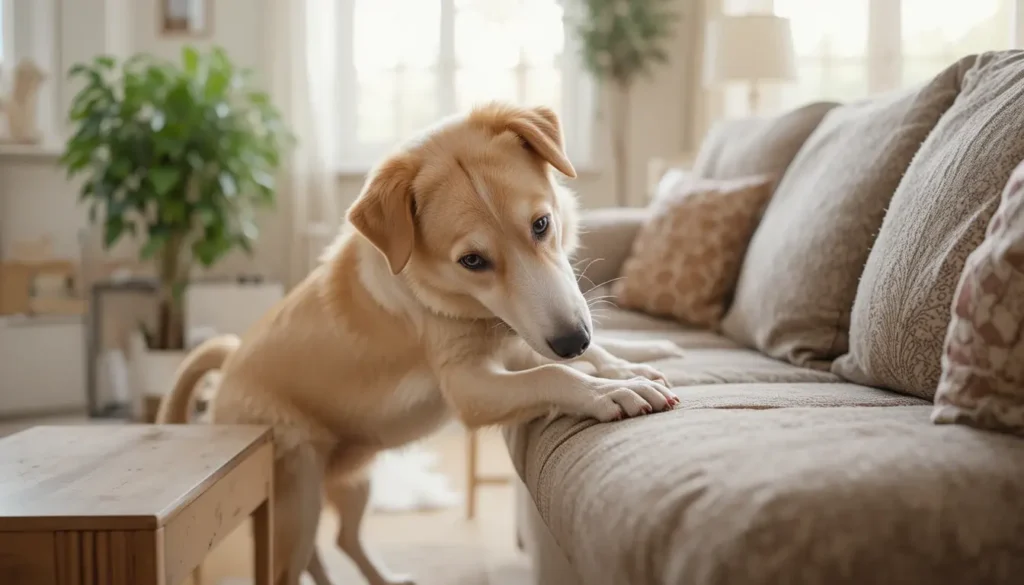You walk into the room and freeze. The corner of your couch looks shredded. Tiny claw marks run across the side, threads pulled and torn. Your dog sits nearby, tail wagging, unaware that your heart just dropped.
You’ve spent money on toys, given attention, and tried saying “no” — but the scratching keeps happening. You start wondering if your dog is just being stubborn. But the truth is, scratching is rarely about misbehavior. It’s communication. It’s habit. It’s unmet need. And it can be fixed.
By the end of this article, you’ll understand why your dog scratches furniture, how to stop it without yelling, and how to build habits that keep both your home and your dog calm.
Why Dogs Scratch Furniture
Before stopping the behavior, you must know why it exists. Dogs don’t scratch out of spite. They scratch to release tension, mark territory, or seek comfort.
Scratching helps them stretch their muscles. It also leaves a scent through glands in their paws. To your dog, your sofa is more than furniture — it’s part of their safe space.
Another reason is boredom. When your dog has too much energy and not enough mental work, scratching becomes an outlet. It’s a way to release frustration or seek your attention.
Some dogs also do it when anxious. Changes in environment, loud sounds, or lack of routine can make them restless. When that happens, furniture becomes the first target because it’s nearby, soft, and comforting.
Knowing the cause is the first step to solving it. Every reason points to a need you can meet in a healthier way.
Before you correct the scratching, you need to see when it happens.
Does your dog scratch when left alone? When guests come in? After meals? During storms? Watch closely for a few days. Write down each incident. The pattern will reveal the trigger.
If the scratching happens during separation, your dog may have anxiety. If it happens after play, it may be habit or overstimulation. If it’s random, your dog might just lack structure.
Understanding when and why gives you control. Without that, you’ll only be reacting to symptoms. Dogs repeat behaviors that bring relief or attention. Identifying the moment before scratching starts is where training begins.
Once you know what triggers it, you can replace the habit.
Scratching releases energy, so you must give your dog better ways to use it. Walks help, but structure matters more than distance. Try two focused walks a day — one in the morning, one before evening rest. Keep your dog at your side, not pulling ahead. The goal is mental work through calm walking.
Add short training sessions during the day. Five minutes of sit-stay, recall, or simple commands keep your dog’s mind engaged. It burns energy faster than long runs.
Toys are also powerful. But don’t leave all of them out. Rotate them. Give your dog one toy at a time and switch it up daily. New textures and challenges hold attention.
If scratching is triggered by anxiety, add comfort tools: a safe bed, gentle background sound, or your worn shirt for scent. The goal is to create calm, not just distraction.
When your dog starts heading toward the furniture, interrupt gently. A firm “leave it” or a hand clap gets attention. Then redirect to a toy or a scratching pad. Praise when your dog chooses the new option. That’s how habit rewiring starts.
Protect Your Furniture While Training
Training takes time. While you work on behavior, protect your furniture from more damage.
Start with physical barriers. Use covers, blankets, or slipcovers on the most targeted spots. Some owners place temporary pet gates or move furniture slightly to break access patterns.
Next, change the scent and texture of the area. Dogs are sensitive to smell. Clean scratched spots with enzyme-based cleaners to remove scent marks. Then apply a safe deterrent spray with mild citrus or bitter apple scent.
You can also use scratching alternatives — pads or boards designed for dogs. Place them near the problem areas. Encourage your dog to use them by adding treats or praise when they touch it.
Make sure your dog’s nails are trimmed. Long nails make scratching satisfying and damaging. Short nails reduce both. Trim them weekly or every two weeks. If your dog resists, desensitize them slowly — touch the paws daily and reward calm behavior before trimming.
This phase is about management. You’re not punishing the past; you’re preventing the future while teaching new habits.
Scratching can only fade if the new habits stay consistent.
Create a daily rhythm your dog can predict. Dogs feel safe when they know what’s next. Feed, walk, and rest at the same times each day. The more stable the environment, the less anxious scratching becomes.
Include mental enrichment. Snuffle mats, treat puzzles, or basic scent games make your dog think. Mental fatigue builds calm confidence and cuts the urge to act out.
If your dog scratches when alone, work on separation training. Start by leaving for short moments — thirty seconds, then one minute, then three. Return calmly without excitement. Increase time gradually. This builds trust that you’ll always come back.
Reward calm behavior around furniture. Every time your dog chooses to lie down instead of scratching, mark it with a “good” or give a small treat. Reinforce what you want more of.
The secret is repetition. Dogs learn through pattern. Each time you guide them away from furniture and reward the right behavior, you rewire their instinct. Within weeks, you’ll notice less scratching. Within months, it can stop completely.
Address Emotional Causes
Some scratching doesn’t come from boredom or energy — it comes from emotion. Dogs experience stress, fear, and loneliness in their own way.
If your dog scratches when you leave, it’s about attachment. Create calm exits and returns. Don’t rush to comfort when they panic; that feeds anxiety. Stay calm so they mirror it.
If it happens after loud sounds or changes in the home, use desensitization. Play low-volume recordings of triggers (like thunder or traffic) while giving treats or calm praise. Gradually increase volume over days until the sounds no longer cause tension.
Sometimes scratching is a symptom of lack of confidence. Rescue dogs, new adoptions, or dogs with past neglect use scratching as a coping mechanism. These dogs need patience more than correction. Spend quiet time sitting near them, rewarding small calm moments. Over time, they’ll trust the environment and no longer need to self-soothe through scratching.
Emotional balance is the real cure. Once the mind is calm, the body follows.
Where your dog spends time matters. Rearrange the space to support better behavior.
Give your dog a defined area — a bed, crate, or mat that’s truly theirs. Place it in a calm corner, not near doors or windows that trigger excitement. Make it comfortable but not overstimulating.
Keep chewable or scratchable toys in that zone. Every time your dog scratches furniture, calmly guide them to their space. Say “bed” or “place” and reward when they stay there.
If your dog scratches near windows, block the view temporarily. Visual triggers can feed anxiety or overexcitement. Use curtains or window film to create calm focus.
The goal is environmental association. Your dog learns that calm happens in certain spaces, not chaos. Over time, that mental structure reshapes habits naturally.
Fix the Root — Not Just the Behavior
Many owners stop at correction, but long-term change requires addressing the foundation.
Scratching behavior connects directly to lifestyle. A dog that doesn’t feel fulfilled will find release through something — chewing, barking, or scratching. So look beyond the surface.
Ask:
- Does my dog get clear exercise every day?
- Do I provide structure and direction?
- Is my communication calm and consistent?
- Does my dog feel secure when alone?
The more balanced your dog’s daily life becomes, the fewer behavioral symptoms appear. Scratching isn’t the problem — it’s the signal. Your job is to decode it, meet the need, and guide with clarity.
When you fix the reason, the habit fades naturally.
If the scratching continues after consistent effort, it’s time to get expert help.
Some cases connect to deep anxiety, trauma, or lack of early socialization. A professional dog trainer or behaviorist can observe your dog’s patterns and create a custom plan.
Veterinarians can rule out medical causes too. Skin irritation, allergies, or joint pain can make dogs scratch surfaces for relief. Always ensure there’s no physical reason behind it.
Seeking help doesn’t mean failure. It means you’re giving your dog the best chance at a healthy, stress-free life.
When you start applying these steps, change happens quietly. One day, you notice your dog walking past the couch without stopping. Their attention goes to the toy, or they rest calmly on their bed.
It’s not a miracle. It’s the result of understanding and consistency. You replaced frustration with guidance. You gave your dog new ways to meet old needs.
And your home starts to feel peaceful again — not because the furniture is safe, but because the relationship between you and your dog has shifted. There’s trust, communication, and calm control.
The goal isn’t to stop scratching alone. It’s to build balance — a home where your dog feels understood, guided, and fulfilled.
When a dog scratches furniture, it’s not rebellion. It’s a message that something is missing. Through structure, attention, and care, you can meet that message with action instead of anger.
In time, your dog learns what peace feels like. Furniture stays intact. Anxiety fades. And the bond between you deepens beyond habit and correction — it becomes partnership.
The reward isn’t just a clean sofa. It’s a calm dog that trusts your direction and a home that finally feels whole again.




